Intel Core i9-12900KS Review: The Fastest Gaming Chip Ever
Intel's Special Edition hits 5.5 GHz with ease.

Intel's Core i9-12900K arrived last year as the fastest gaming CPU we've ever tested, but the new Special Edition Core i9-12900KS pushes the Alder Lake family up to a blistering 5.5 GHz, a record high for PCs, making it the fastest desktop PC chip in all categories. The 12900KS comes to market on April 5, but we snagged a chip to put it to the test ahead of the final launch.
But that isn't the final word yet: AMD has its $449 Ryzen 7 5800X3D waiting in the wings. The 5800X3D comes with the first 3D-stacked SRAM for desktop PCs, granting the chip a whopping 96MB of L3 cache that AMD says will take back the crown of the best CPU for gaming when it arrives on April 20.
Make no mistake, Intel's goal with the 12900KS is to cement itself atop the performance charts to cut off the 5800X3D before it even arrives on the market. Intel aims to accomplish this feat by leveraging the 12900K's existing 16-core 24-thread design, but with a higher binning that supports speeds up to 5.5 GHz on two cores and up to 5.2 GHz for all-core boosts, both enabled by adding in Intel's most advanced boosting tech.
| Row 0 - Cell 0 | U.S. Price | Cores | Threads | P-Core Base/Boost | E-Core Base/Boost | TDP / PBP / MTP | DDR4-3200 | L3 Cache |
| Core i9-12900KS | $739 | 8P + 8E | 16 Cores / 24 threads | 3.4 / 5.5 GHz | 2.5 / 4.0 GHz | 150W / 241W | DDR4-3200 / DDR5-4800 | 30MB |
| Core i9-12900K / KF | $589 (K) - $564 (KF) | 8P + 8E | 16 Cores / 24 threads | 3.2 / 5.2 GHz | 2.4 / 3.9 GHz | 125W / 241W | DDR4-3200 / DDR5-4800 | 30MB |
| Core i7-12700K / KF | $409 (K) - $384 (KF) | 8P + 4E | 12 Cores / 20 threads | 3.6 / 5.0 GHz | 2.7 / 3.8 GHz | 125W / 190W | DDR4-3200 / DDR5-4800 | 25MB |
| Core i5-12600K / KF | $289 (K) - $264 (KF) | 6P + 4E | 10 Cores / 16 threads | 3.7 / 4.9 GHz | 2.8 / 3.6 GHz | 125W / 150W | DDR4-3200 / DDR5-4800 | 16MB |
That comes at the cost of extra power, though: The Core i9-12900KS comes with a 150W processor base power (PBP), a record for a mainstream desktop processor. As we'll show below, it's an understatement to say the 12900KS runs hot, so it requires the beefiest of cooling solutions. However, as we'll detail, some of that tendency to run hot is by design to enable a new level of performance for desktop PCs.
The speedy 12900KS is sure to satisfy deep-pocketed performance addicts, and it comes with the same overall feature set as the 12900K, like support for DDR5 and PCIe 5.0 on the desktop. AMD can't match that type of connectivity until its 5nm Ryzen 7000 ‘Raphael’ Zen 4 CPUs arrive later this year. The 12900KS also comes with Alder Lake's new hybrid x86 design that combines eight big and fast Performance cores (P-cores) with two four-core clusters of small and powerful Efficiency cores (E-cores) that chew through background processes.
Intel's Core i9-12900K catapulted the company back to the top of the performance and value charts after the beating it took at the hands of AMD's Ryzen 5000 family, but AMD is finally firing back with seven new chips of its own that will come to market this month. Intel's Core i9-12900KS is Intel's brazen 'power and price be damned' attempt at keeping the performance crown at all costs, just like we saw with Intel's only other 'Special Edition' chip, the Core i9-9900KS.
All of this means that while Intel's 12900KS delivers strong performance that leads our CPU benchmark hierarchy, its hefty $739 premium might not be as good of a buy for gaming as AMD's $449 5800X3D. However, the eight-core 5800X3D won't be able to keep pace in any other type of work, as the 16-core Core i9-12900KS has a core count and frequency advantage. Here's how Intel's latest Special Edition stacks up.
Intel Alder Lake-S Core i9-12900KS Specifications and Pricing
The Core i9-12900KS is a Special Edition chip, but Intel hasn't said if it will only produce a limited number as it did for the 'Limited Edition' Core i7-8086K. However, we do know that the 12900K's thousand-unit price (effectively the wholesale MSRP) lands at $739, so we can expect to see these chips at retail for around $775 to $800 at launch.
That's a surprising premium over the 16-core 32-thread Ryzen 9 5950X that now retails for around $600, and it's also much more expensive than the $449 Ryzen 7 5800X3D that AMD says will be faster at games. This means there's a good chance we could see the Core i9-12900KS sell for lower than its suggested pricing after the initial demand is satisfied.
| Row 0 - Cell 0 | U.S. Price | Cores | Threads | P-Core Base/Boost | E-Core Base/Boost | TDP / PBP / MTP | DDR4-3200 | L3 Cache |
| Ryzen 9 5950X | $600 ($799) | 16P | 32 threads | 3.4 / 4.9 GHz | - | 105W | DDR4-3200 | 64MB (2x32) |
| Core i9-12900KS | $739 | 8P + 8E | 16 Cores / 24 threads | 3.4 / 5.5 GHz | 2.5 / 4.0 GHz | 150W / 241W | DDR4-3200 / DDR5-4800 | 30MB |
| Core i9-12900K / KF | $589 (K) - $564 (KF) | 8P + 8E | 16 Cores / 24 threads | 3.2 / 5.2 GHz | 2.4 / 3.9 GHz | 125W / 241W | DDR4-3200 / DDR5-4800 | 30MB |
| Ryzen 9 5900X | $450 ($549) | 12P | 24 threads | 3.7 / 4.8 GHz | - | 105W | DDR4-3200 | 32MB (1x32) |
| Core i7-12700K / KF | $409 (K) - $384 (KF) | 8P + 4E | 12 Cores / 20 threads | 3.6 / 5.0 GHz | 2.7 / 3.8 GHz | 125W / 190W | DDR4-3200 / DDR5-4800 | 25MB |
| Core i7-11700K | $409 | 8P | 16 threads | 3.6 / 5.0 GHz | - | 125W | DDR4-3200 | 16MB |
| Ryzen 7 5800X | $350 ($449) | 8P | 16 threads | 3.8 / 4.7 GHz | - | 105W | DDR4-3200 | 32MB |
The Core i9-12900KS is functionally the same as the Core i9-12900K, which you can read much more about here. We also have deep-dive coverage of the Alder Lake SoC design and core microarchitectures here, along with a broader overview in our Alder Lake all we know article.
The 12900KS has eight P-cores just like the 'K' version, but they now boost up to 5.5 GHz (300 MHz increase) if certain conditions are met. The chip also features eight E-cores that also receive an extra 100 MHz of clock speed. Intel has a total of five boost technologies (deeper explanation here), but the standard Core i9-12900K only supports two of them. The 12900KS supports all five to deliver higher clock speeds.
| Row 0 - Cell 0 | Above 90C | 70-90C | Below 70C |
| Core i9-12900K - All-Core Boost | 5.0 GHz | 5.1 GHz | 5.2 GHz |
Intel's single-core Thermal Velocity Boost (TVB) tech allows the two fastest favored cores to boost to 5.5 GHz if they are below 70C, while the all-core TVB supports 'up to' the frequencies in the table above. The 12900KS also has Adaptive Boost Technology, allowing dynamic all-core turbo frequency adjustments when four or more cores are active. This feature doesn't have a guaranteed boost threshold — it will vary based on chip quality, your cooler, and power delivery. Think of Intel's Adaptive Boost Technology (ABT) much like a dynamic auto-overclocking feature that applies to all-core boosts, but using it doesn't void the warranty.
These higher clock speeds require more power. As a result, Intel has increased the Processor Base Power (PBP) to 150W, an increase of 25W over the Core i9-12900K. However, the Maximum Turbo Power (MTP) value, which represents the highest power level during boost activity, remains the same at 241W. Naturally, all bets are off when you remove the power limits, which happens by default on most high-end motherboards.
All Alder Lake chips support DDR4-3200 or up to DDR5-4800 memory, but caveats apply. Alder Lake chips expose up to 16 lanes of PCIe 5.0 (technically for storage and graphics only, no networking devices) and an additional four lanes of PCIe 4.0 from the chip for M.2 storage. The 12900KS also comes armed with the UHD Graphics 770 engine with 32 EUs that run at a 300/1550 MHz base/boost, just like the standard 12900K. However, there is no graphics-less F-series variant.
Test Setup
We tested the 12900KS's boosting, power and thermal characteristics extensively, finding that the chip easily and frequently boosts to 5.5 GHz. It also sustains up to a 5.2 GHz boost clock on all P-cores, though not under all conditions. The peak 305W of power consumption we recorded has an impact on thermals, which regularly stay at 100C under heavy multi-core loads. That's because Intel's auto-overclocking ABT feature is designed to extract the full performance available within the spec'd temperature range. You can find that testing after the game and application benchmarks below.
Alder Lake's Thread Director technology steers threads to the correct type of cores. This tech works best with Windows 11, so we use that for testing. It's important that you know that these chips can suffer in very few multi-threaded workloads in Windows 10. You can correct those issues either via command-line utilities or third-party software, like Process Lasso, and receive the full expected performance.
Aside from a few errant programs, the overall trends between Windows 10 and 11 are similar. As such, we're not going to post the redundant Windows 10 benchmarks in this article. We also stuck with DDR4 for this round of testing, as overall performance trends are generally the same between DDR4 and DDR5. We have a deeper dive into what that looks like in our initial 12900K review. We tested in the following two configurations:
Get Tom's Hardware's best news and in-depth reviews, straight to your inbox.
- Core i9-12900KS NoPL DDR4: Corsair H115i 280mm water cooler, power limits removed, memory at DDR4-3200 in Gear 1 mode
- Core i9-12900KS StockPL DDR4: Corsair H115i 280mm water cooler, Intel recommended stock power limits (150/241W), Stock DDR4-3200 in Gear 1
- Core i9-12900K: Corsair H115i 280mm water cooler, power limits removed, memory at DDR4-3200 in Gear 1 mode
Intel Core i9-12900KS Gaming Benchmarks — The TLDR
As usual, we're testing with an Nvidia GeForce RTX 3090 to reduce GPU-imposed bottlenecks as much as possible, and differences between test subjects will shrink with lesser cards or higher resolutions. Because most of the titles below show little meaningful differentiation at higher resolutions, we only tested four of the seven titles at 1440p.
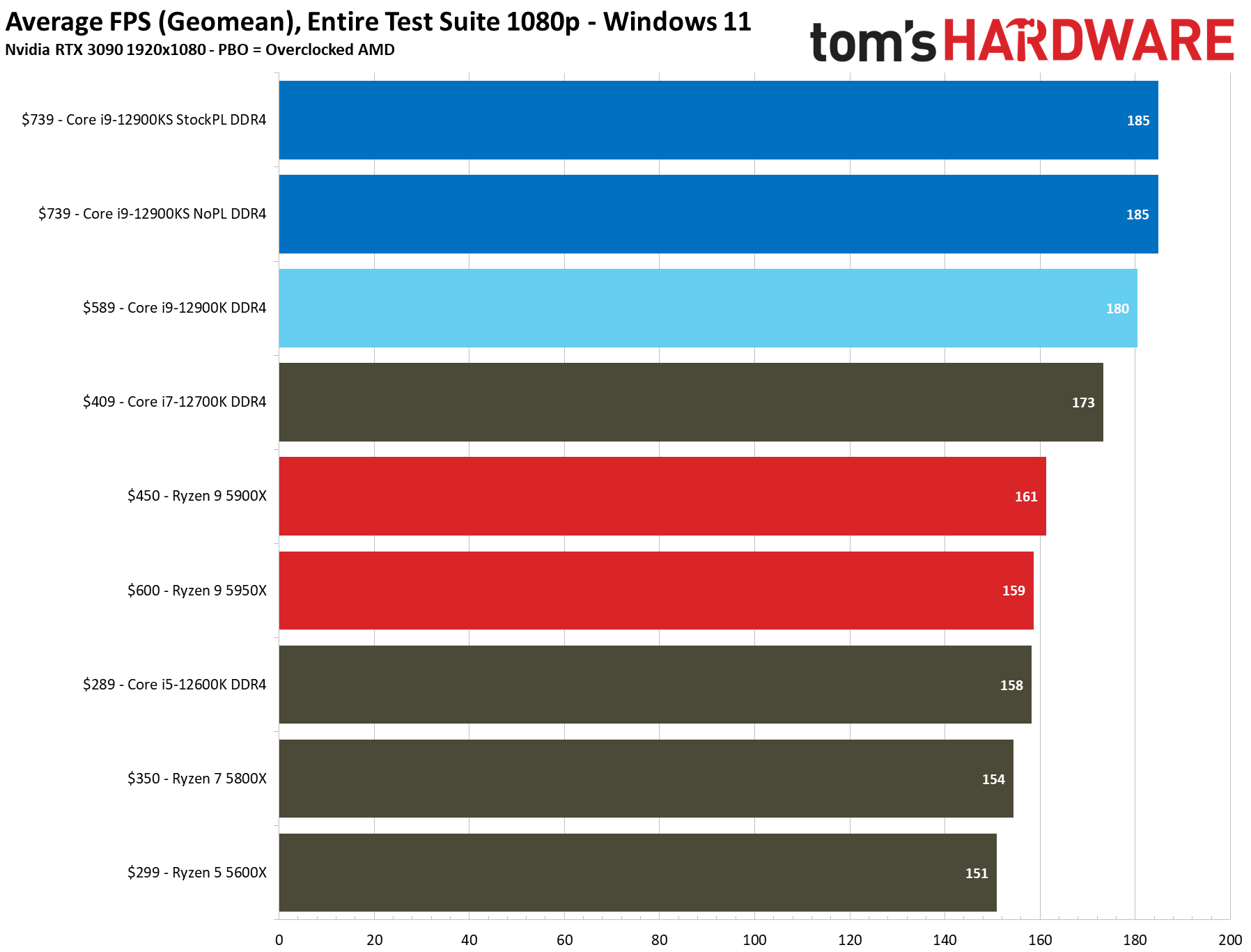



The Core i9-12900KS is now the fastest gaming chip in the world, but only by a slight 2.7% gain over the vanilla 12900K in our cumulative 1080p performance measurement. However, we do see a larger 6.9% gain in the 99th percentile framerates, implying a smoother gaming experience. It is noteworthy that a few of our tested titles are approaching a GPU bottleneck at 1080p, so we might see larger performance deltas when new, more powerful GPUs arrive later this year. However, due to the GPU bottleneck, the difference between the two chips is imperceivable at QHD.
It's noteworthy that we typically test with the power limits fully removed for our standard measurements, so the 12900K in the above charts is running beyond Intel's 'recommended' power settings but remains within warranty. The 12900KS's 5.5 GHz boost frequently engages in any configuration, contributing to a dead tie between the two KS configurations in our cumulative measurement of performance at 1080p.
| Tom's Hardware - 12900KS Baseline | 1080p Game Benchmarks - fps %age |
| Core i9-12900KS DDR4 | 100% |
| Core i9-12900K DDR4 | 97.3% |
| Core i9-12700K DDR4 | 93.5% |
| Ryzen 9 5900X | 87% |
| Ryzen 9 5950X | 85.6% |
| Ryzen 7 5800X | 83.2% |
Moving over to 1440p brings a GPU bottleneck into the equation, so the performance deltas between the chips shrink tremendously. However, those results provide good perspective if you game at higher resolutions and don't plan to upgrade your GPU before buying your next CPU.
Flipping through the 99th percentile charts for both resolutions also shows larger deltas, but we have to view those with caution as Windows 11 is still young and suffers from more framerate variability than our Windows 10 test platform. This could result from yet-to-be-updated game code, the relatively new graphics drivers for Windows 11, or some other combination of factors that could be smoothed out in the future.
The Core i9-12900KS carves out a win in our game testing, but that 2.7% of extra performance at 1080p comes with a 25% price increase. The 12900KS also can't circumvent the general laws of the universe and make the GPU any faster, so you won't see any noticeable gain at higher resolutions or with games that are already bottlenecked by the GPU. That lack of improvement is disappointing, given that most folks that purchase this expensive chip won't be gaming at lower resolutions.
The competition between Intel and AMD is much closer now, so it's best to make an informed decision based on the types of titles you play frequently. Be sure to check out the individual tests below.
3DMark, VRMark, Chess Engines on Intel Core i9-12900KS




Synthetic benchmarks don't tend to translate well to real-world gaming, but they do show us the raw amount of compute power exposed to game engines. It's too bad most games don't fully exploit it.
Far Cry 6 on Core i9-12900KS


F1 2021 on Core i9-12900KS




Hitman 3 on Core i9-12900KS
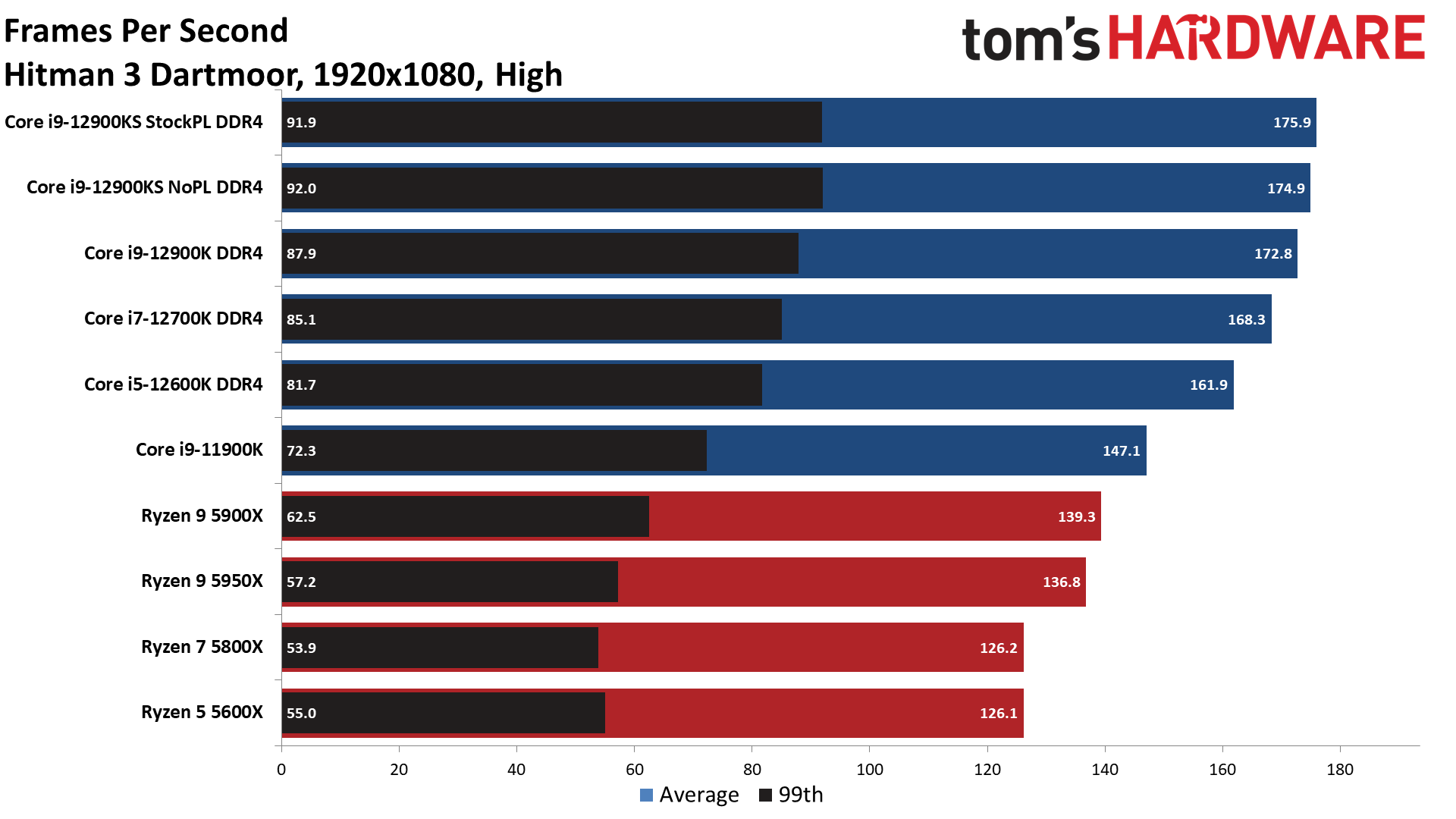

Horizon Zero Dawn on Core i9-12900KS

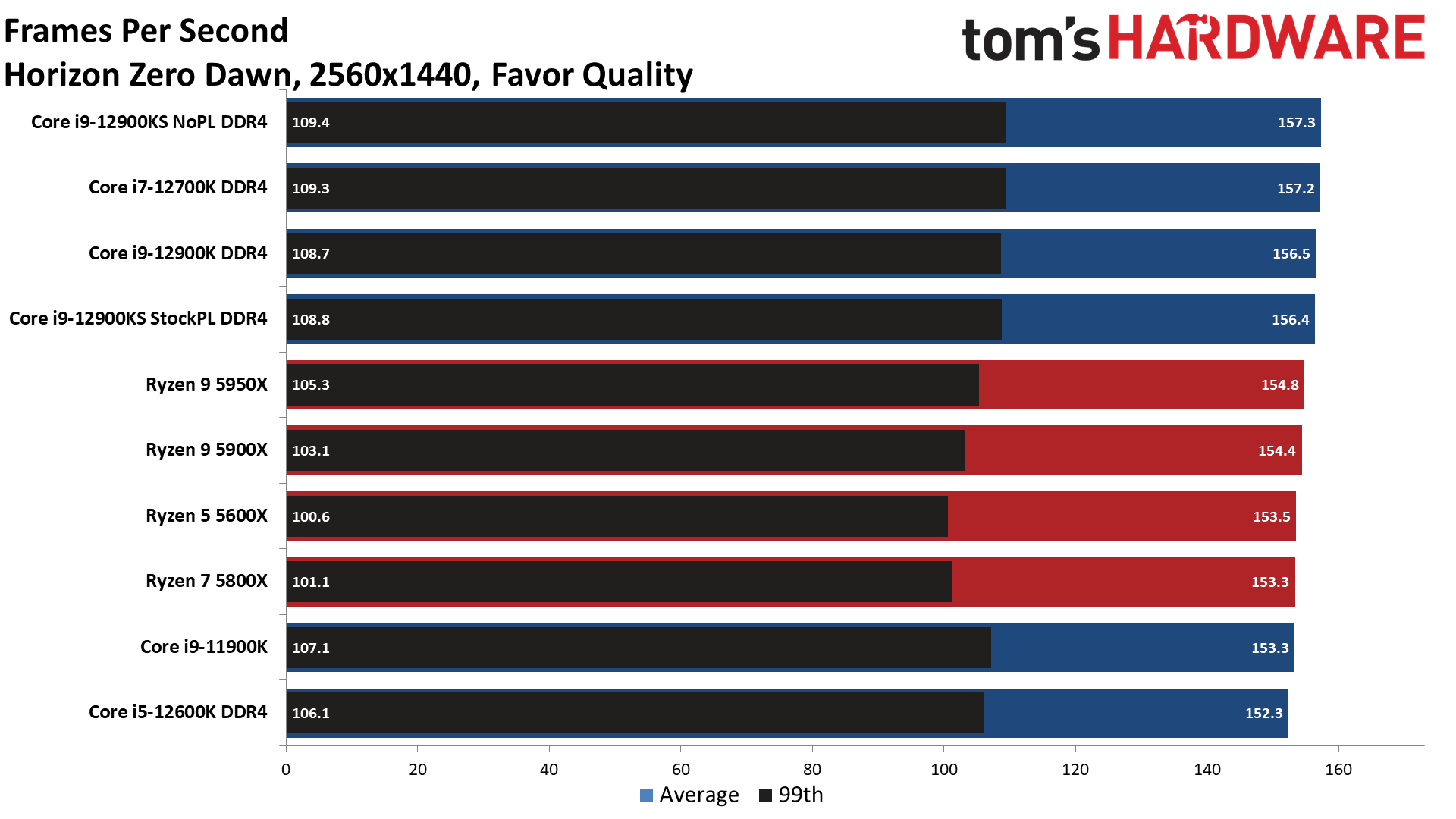


Microsoft Flight Simulator 2021 on Core i9-12900KS


Red Dead Redemption 2 on Core i9-12900KS




Watch Dogs Legion on Core i9-12900KS
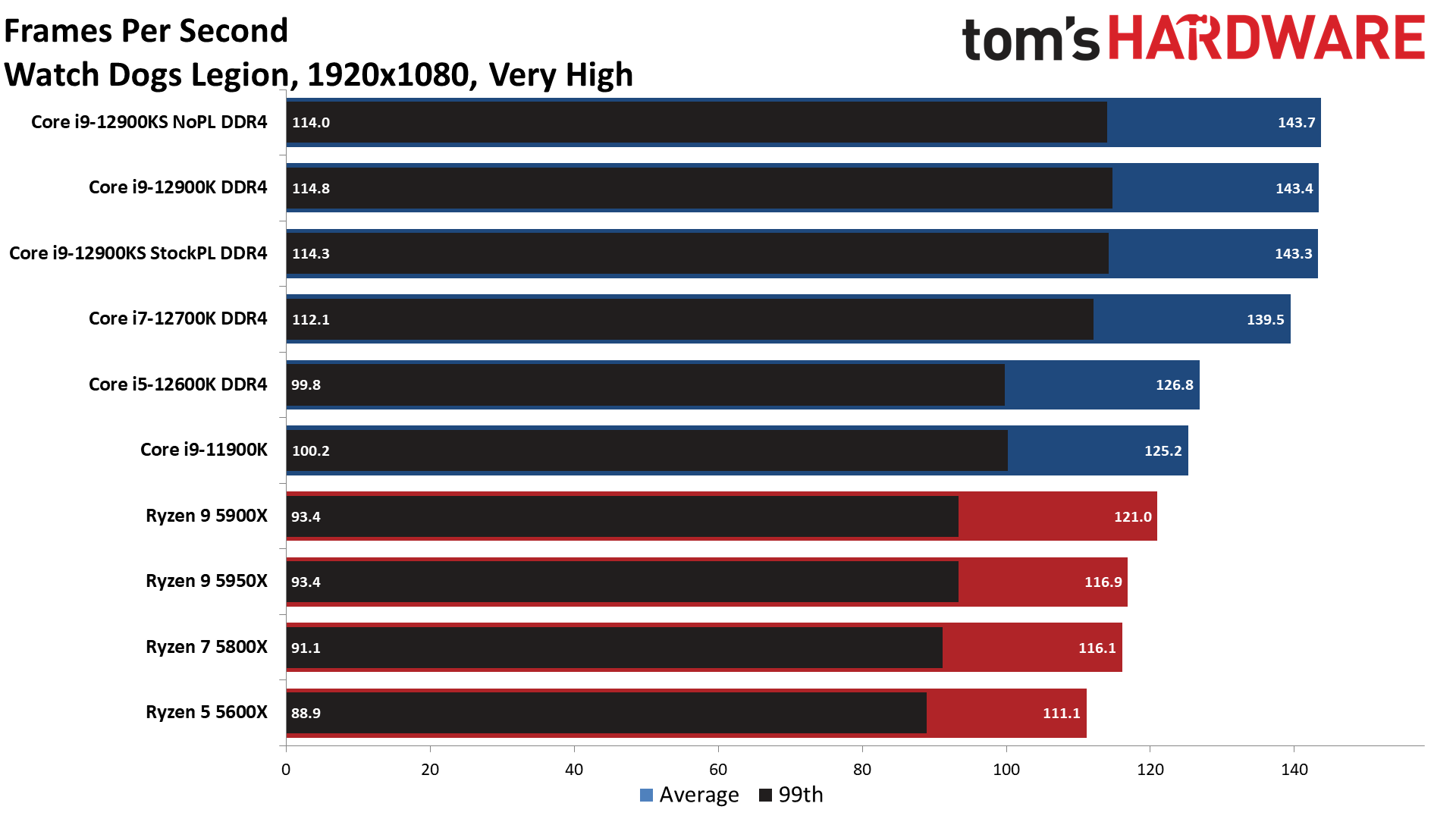



Intel Core i9-12900KS Application Benchmarks — The TLDR


We can boil down productivity application performance into two broad categories: single- and multi-threaded. These slides show the geometric mean of performance in several of our most important tests in each category, but be sure to look at the expanded results below.
With the power limits removed, the Core i9-12900KS is 4% faster in our cumulative measure of threaded performance than the 12900K (which also has its limits removed) and 6.8% faster in the single-threaded measurement.
The Ryzen 9 5950X is more competitive in some specific types of threaded work, like rendering, but the 12900KS is 7.9% faster overall. That gap grows significantly with lightly-threaded applications, where the 12900KS is a whopping 25.9% faster than the 5950X. So while the 12900KS does hold the lead, you're paying quite a premium for the additional performance over the vanilla 12900K.
| Tom's Hardware - Application Benchmarks | Single-Threaded | Multi-Threaded |
| Core i9-12900KS DDR4 | 100% | 100% |
| Core i9-12900K DDR4 | 93.4% | 95.9% |
| Core i9-12700K DDR | 90.9% | 82.6% |
| Ryzen 9 5950X | 79.6% | 92.6% |
| Ryzen 9 5900X | 77.9% | 80% |
| Ryzen 7 5800X | 77.3% | 59.3% |
Rendering Benchmarks on Core i9-12900KS


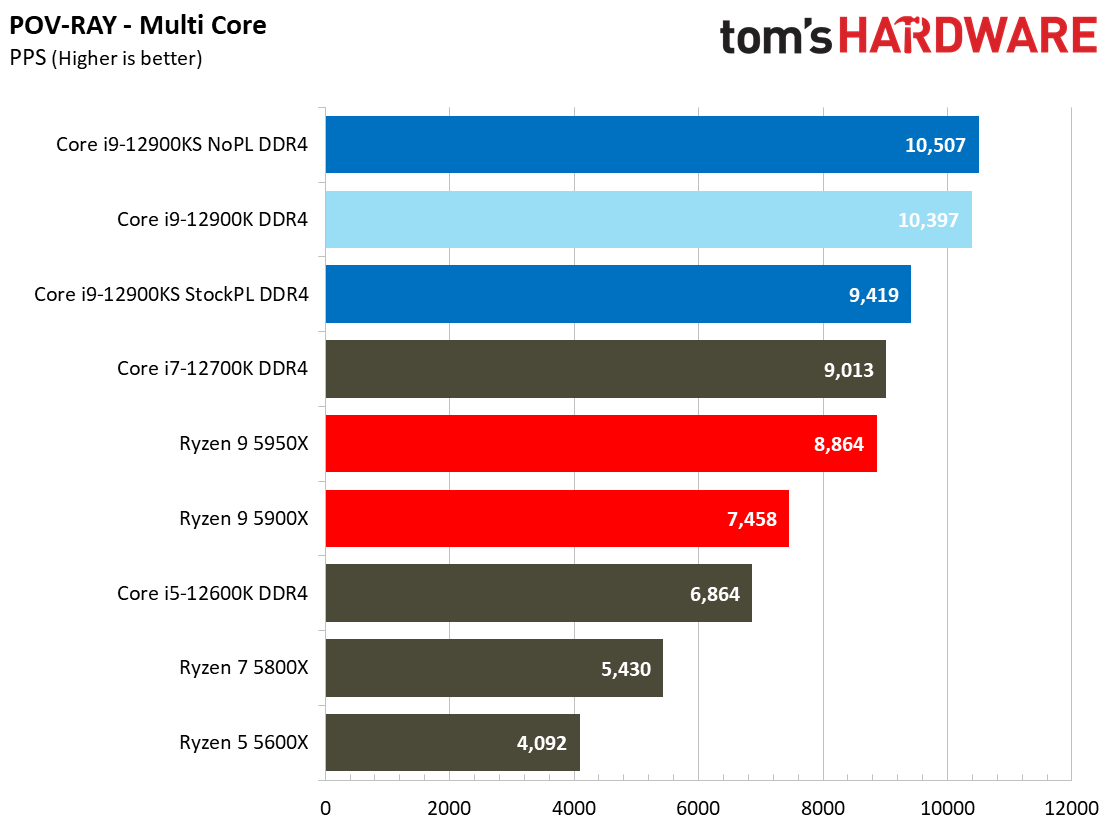






The 12900KS takes the lead in several rendering benchmarks, but the Ryzen 9 5950X leads in Corona, V-Ray, and C-Ray, showing that both chips could be a good choice for different types of multi-threaded rendering workloads. The 12900KS leads the entire Ryzen lineup in the single-threaded rendering benchmarks, showing that the Thread Director places those tasks perfectly onto the faster P-cores.
The 12900K is very close to the 12900KS in most threaded rendering tasks, but there's a much larger delta between the two in single-threaded work.
Encoding Benchmarks on Core i9-12900KS





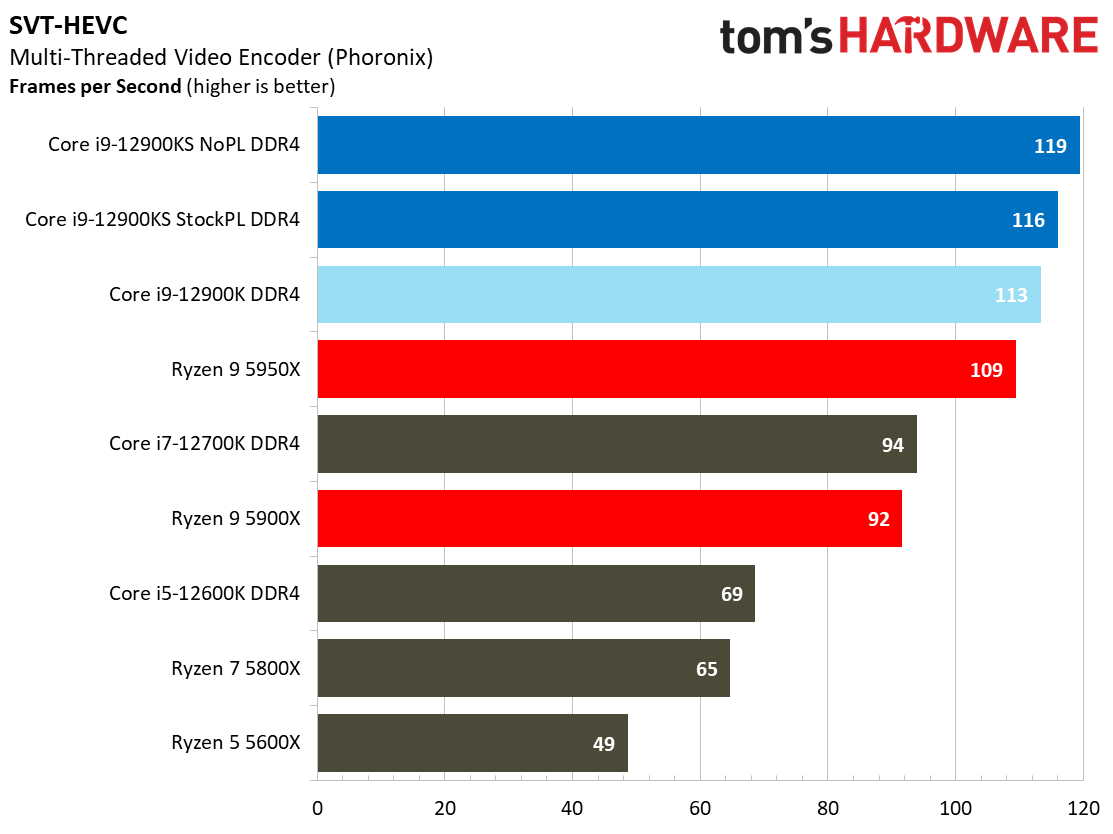

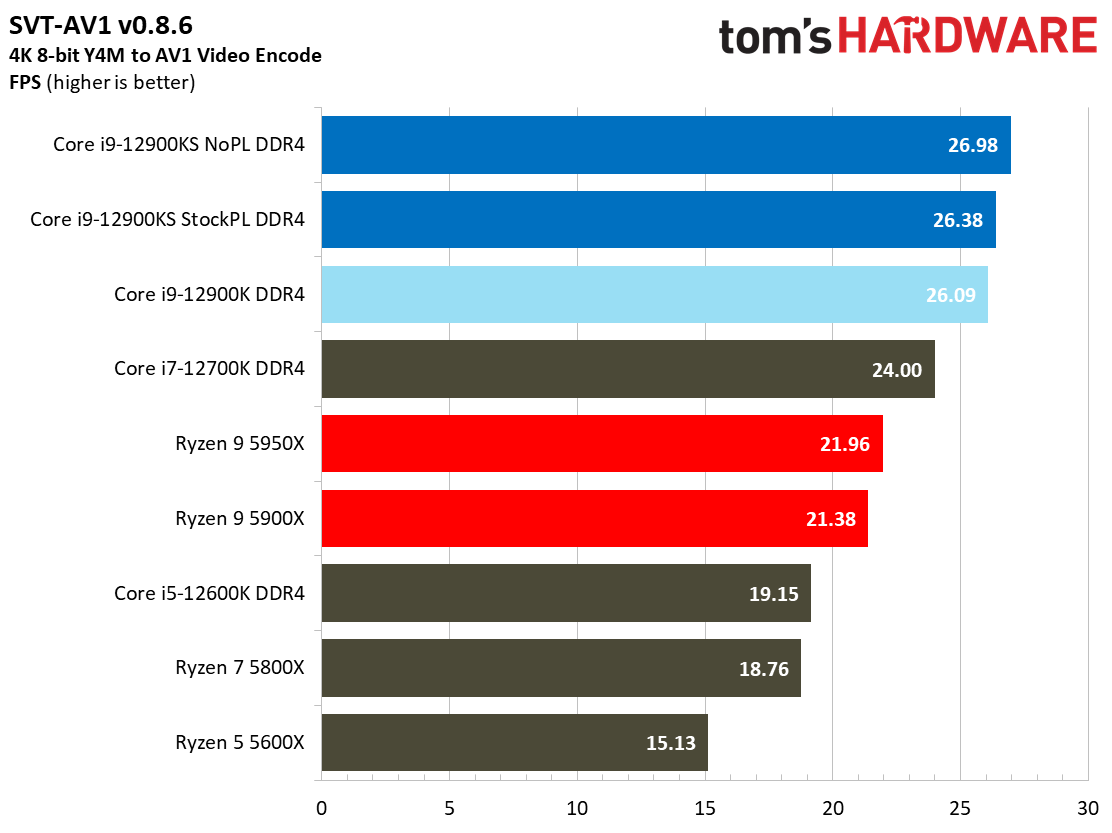
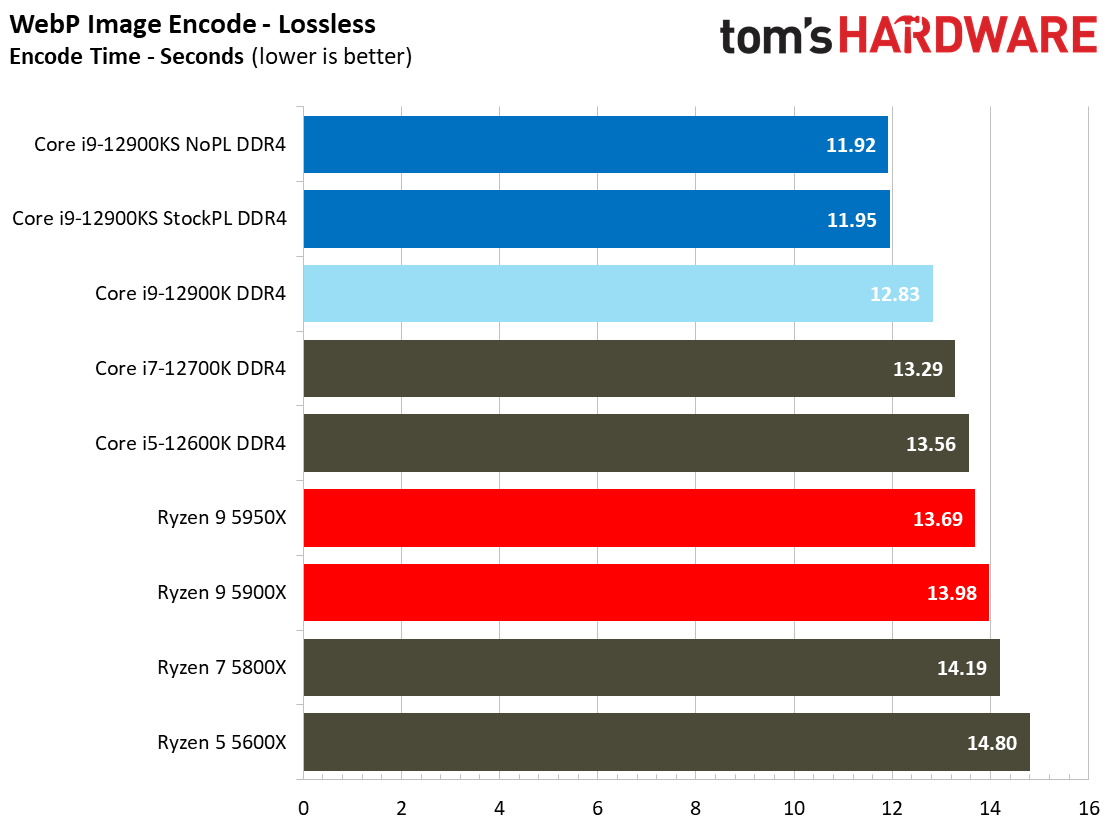

Overall, the Core i9-12900KS leads the encoding workloads, be they lightly- or multi-threaded.
Web Browsing, Office and Productivity on Intel Core i9-12900KS



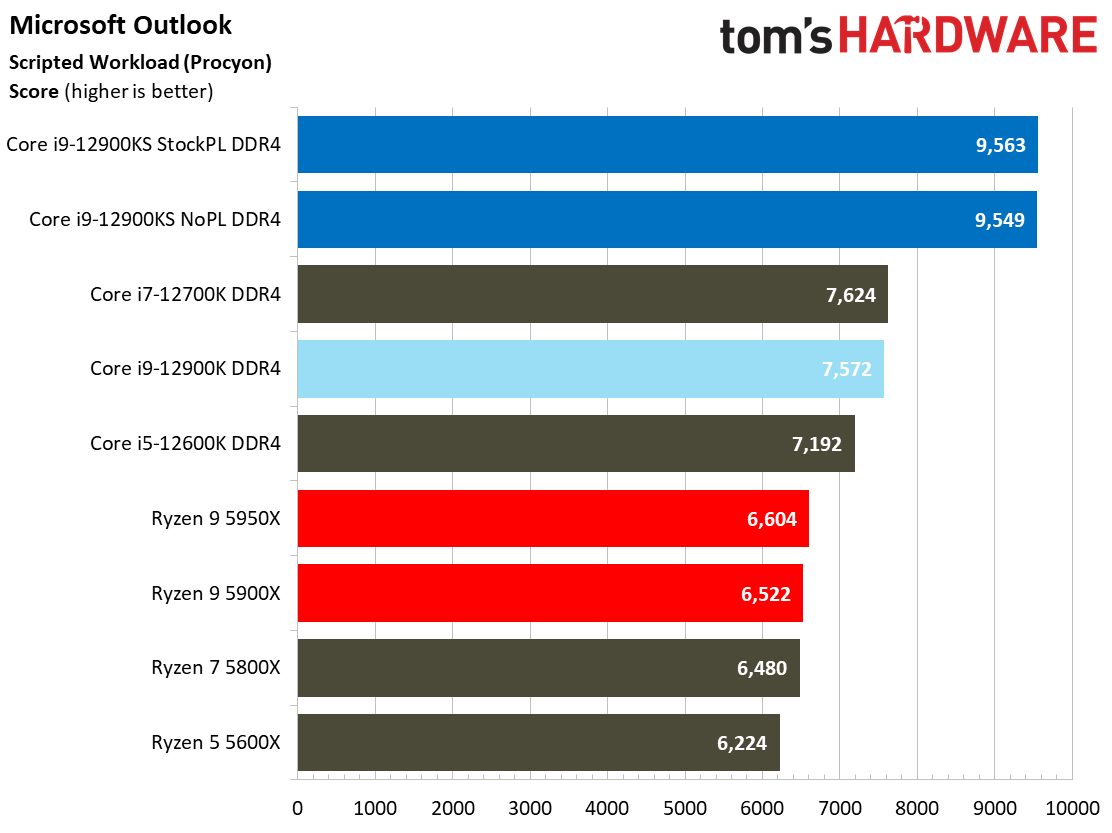




The ubiquitous web browser is one of the most frequently used applications. These tests tend to be lightly-threaded, so a snappy response time is critical. As an extra challenge for Alder Lake, placing these bursty and latency-sensitive workloads directly onto the P-cores requires an ultra-snappy response time from both the Thread Director and the Windows scheduler. That tandem obviously works extremely well as Alder Lake dominates these benchmarks, not to mention the office workloads, too.
Adobe Premiere Pro, Photoshop, and Lightroom on Core i9-12900KS
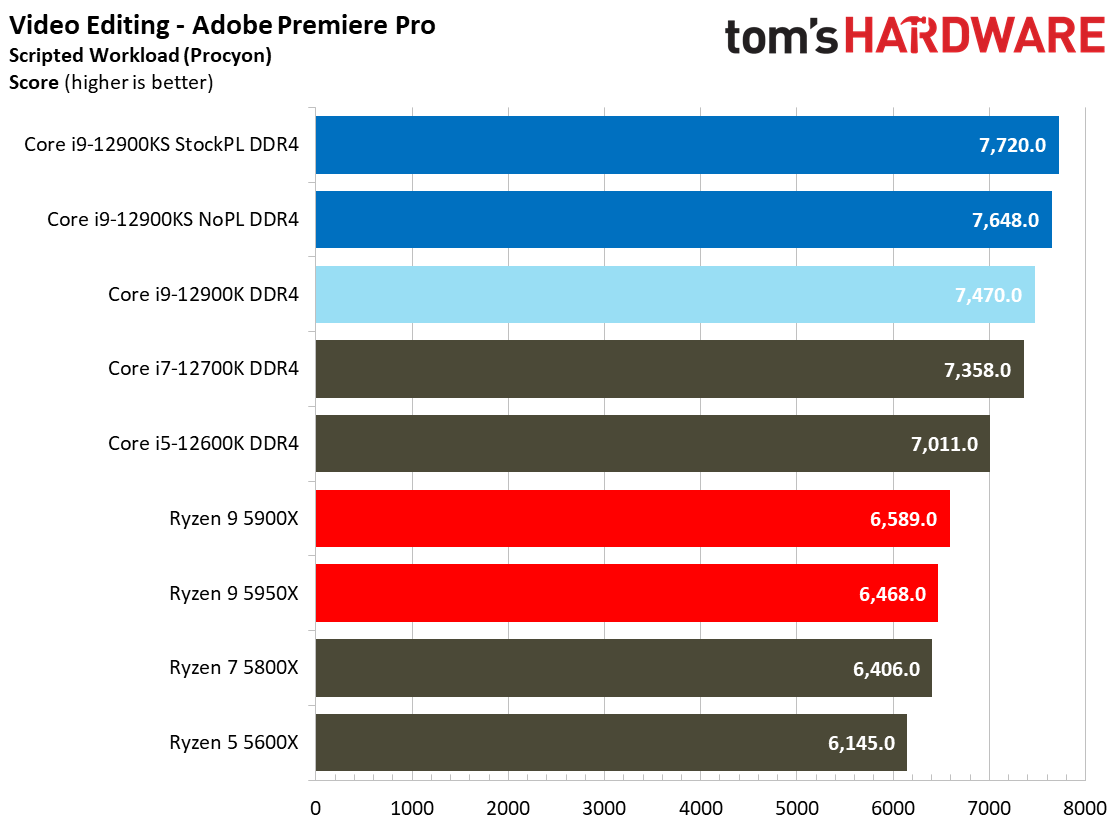


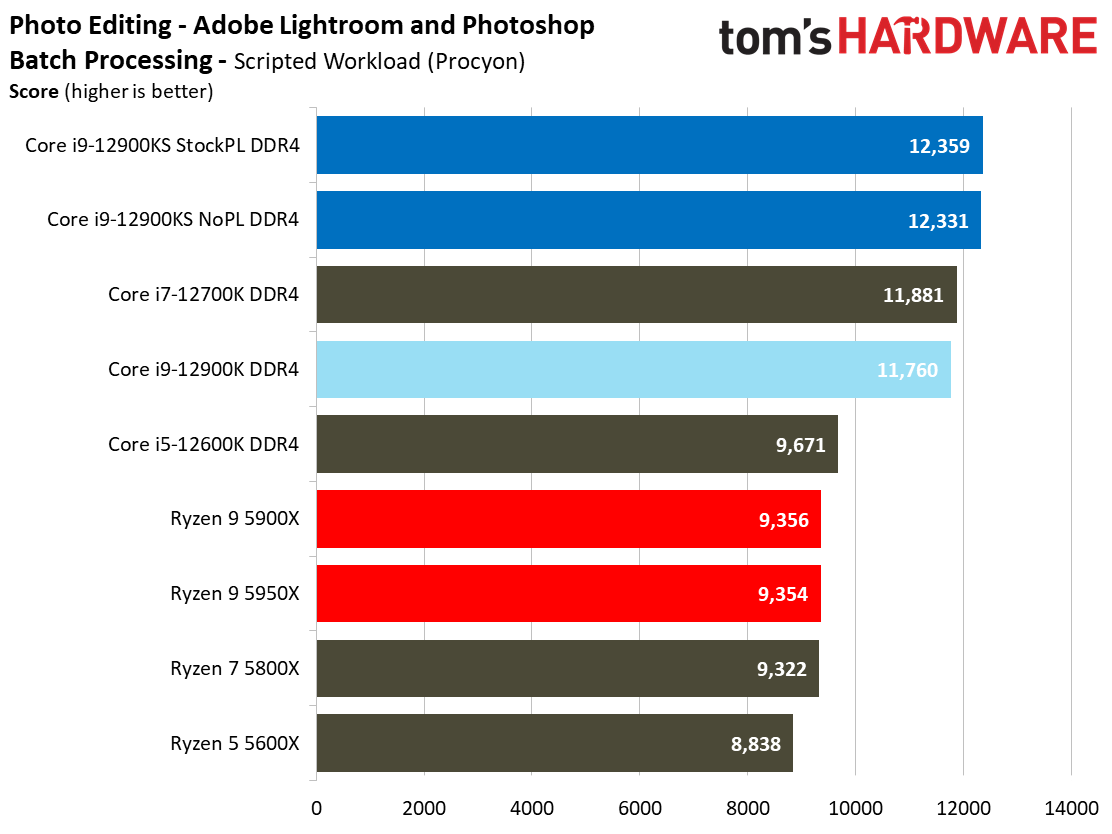


We've integrated the UL Benchmarks Procyon tests into our suite to replace the aging PCMark 10. This new benchmark runs complex Adobe Premiere Pro, Photoshop, and Lightroom workflows with the actual software, making for a great real-world test suite.
The Core i9-12900KS runs the table in this series of Adobe Premiere Pro and Lightroom/Photoshop benchmarks, taking convincing wins over both the Core i9-12900K and the Ryzen comparables.
Compilation, Compression, AVX Benchmarks on Core i9-12900KS
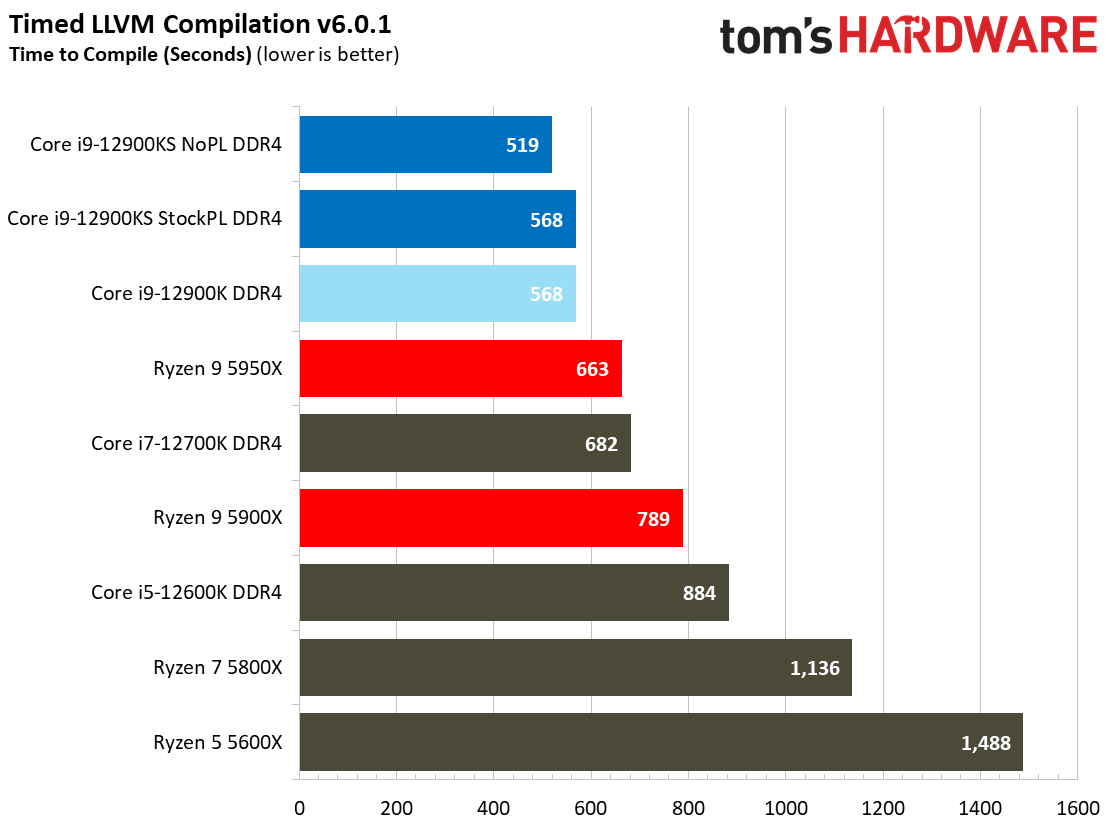

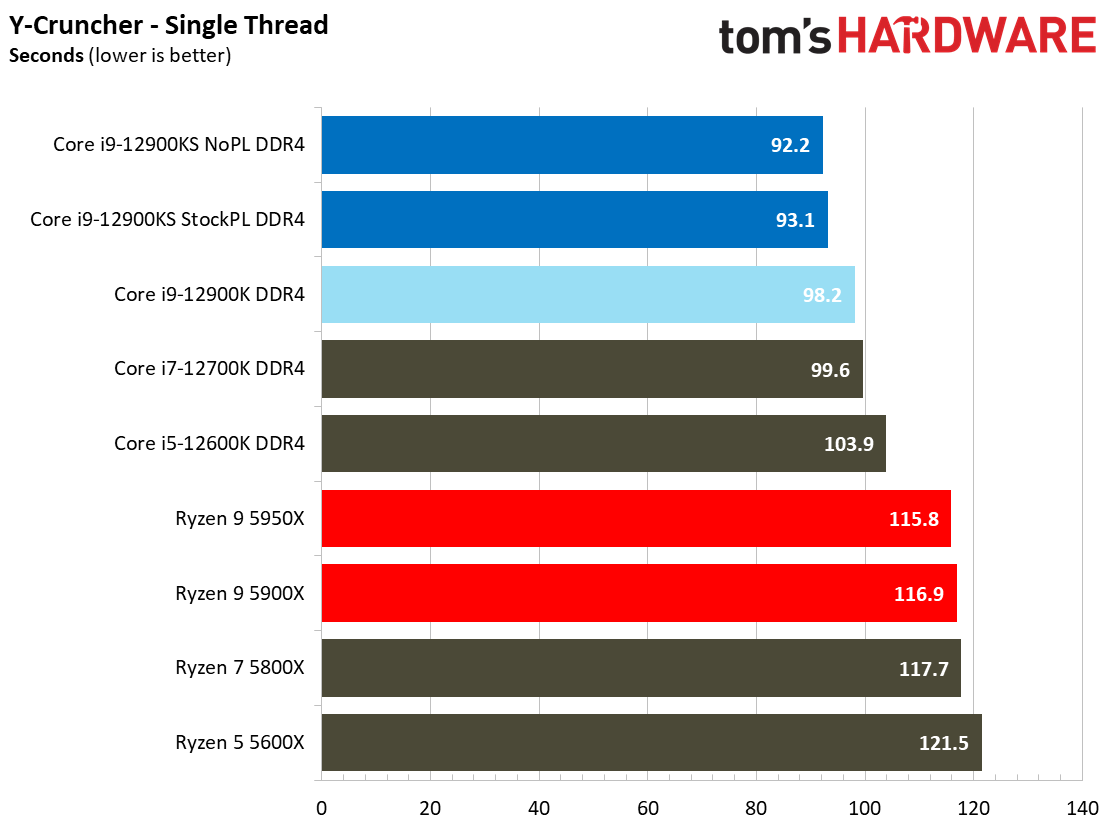
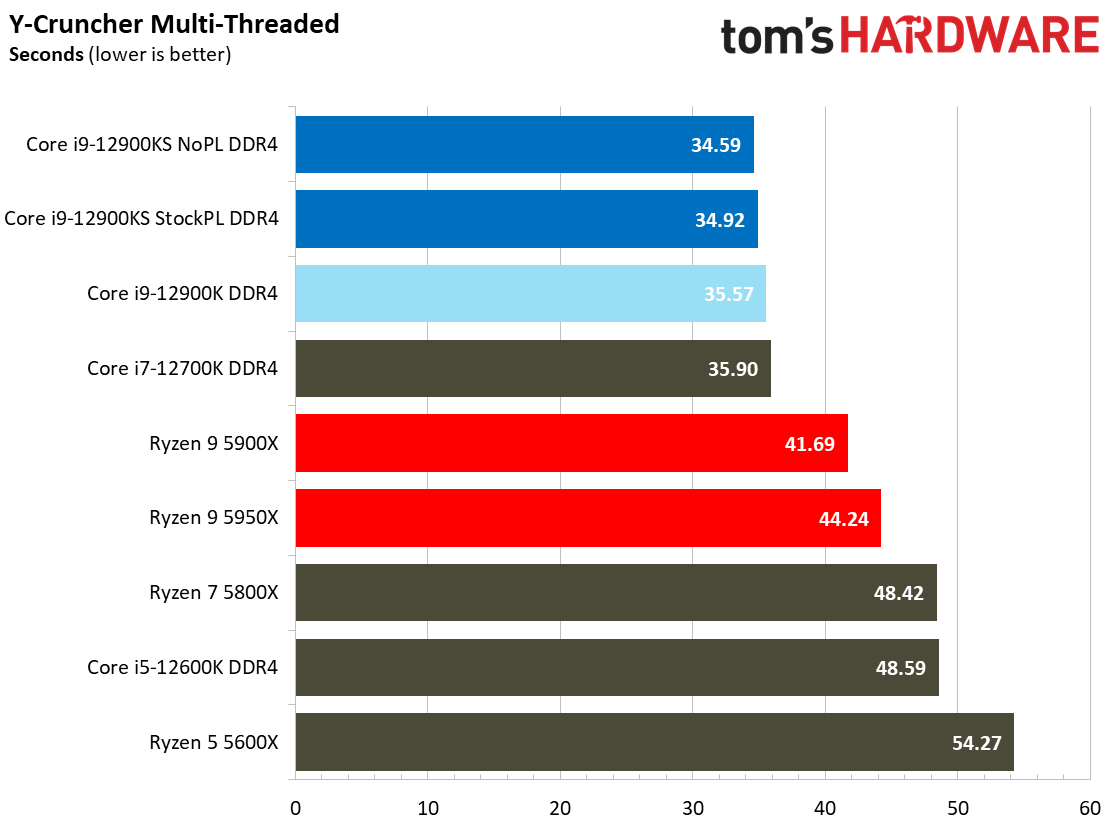







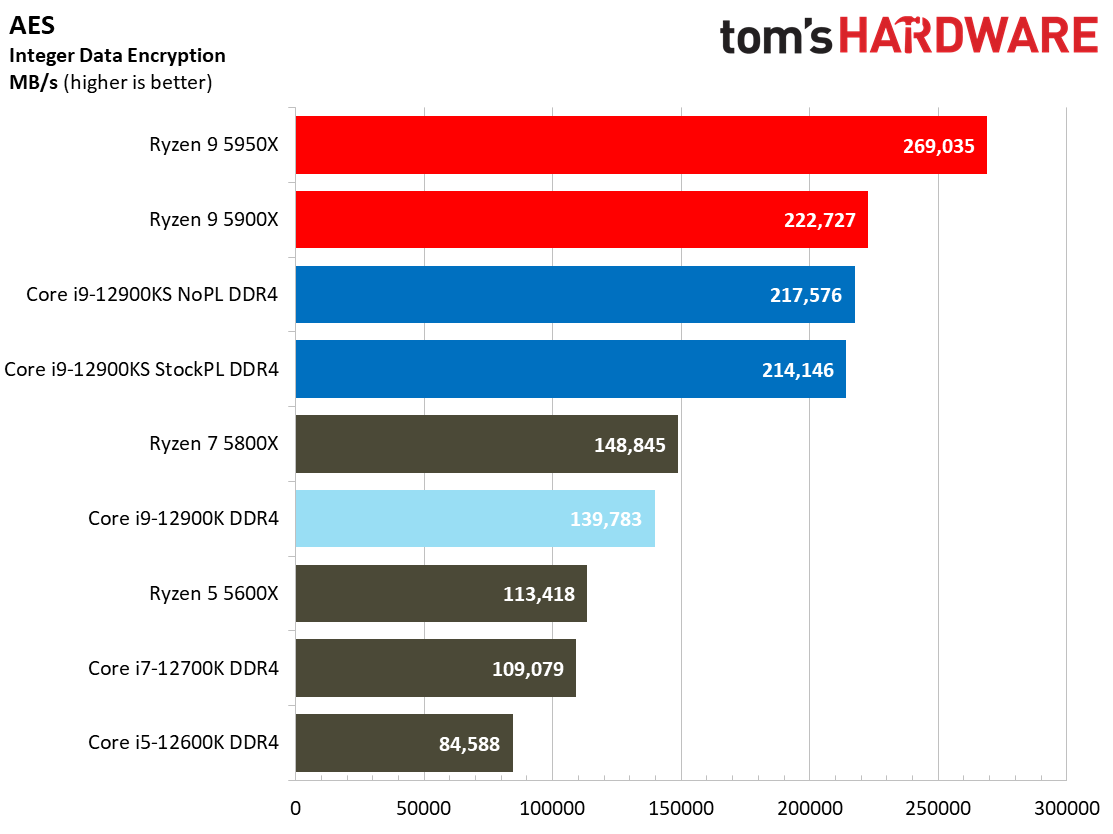

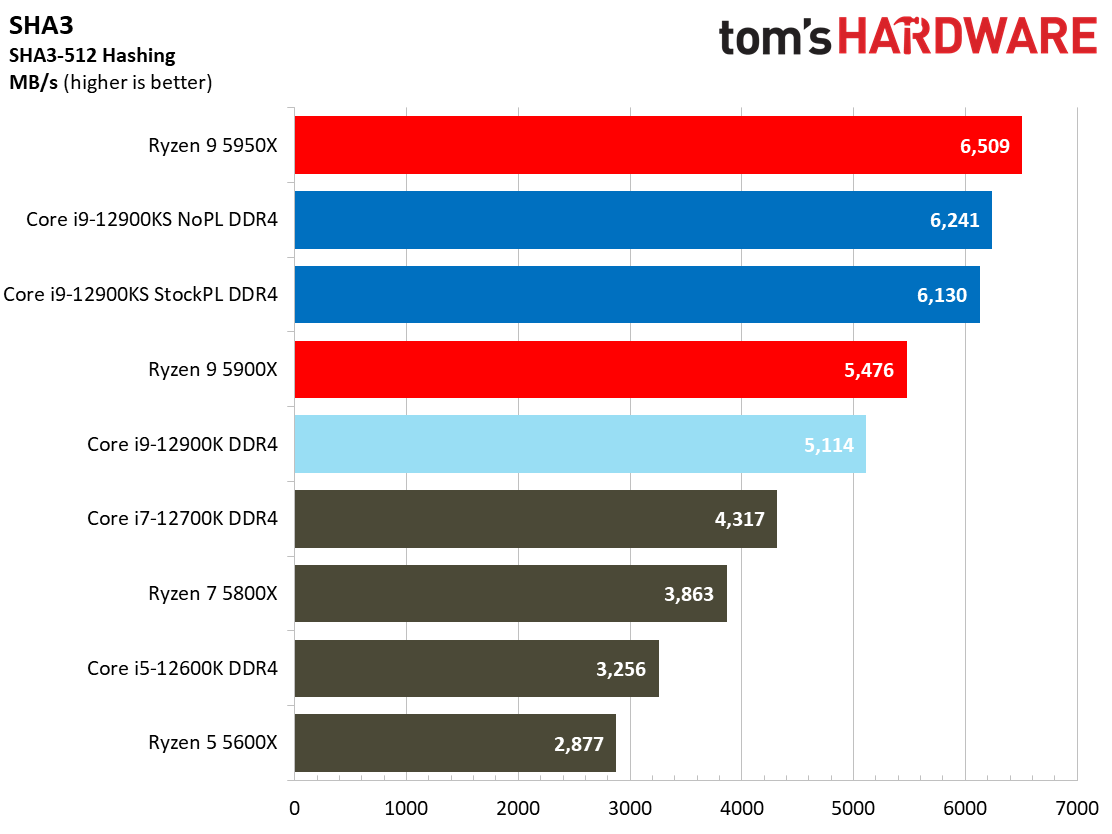
This grab bag of various tests finds the Core i9-12900KS notching several more important wins. From the exceedingly branchy code in the LLVM compilation workload to the massively parallel molecular dynamics simulation code in NAMD, the Core i9-12900KS is impressive. AMD continues to benefit in the SHA3, AES, and HASH benchmarks from its cryptographic optimizations.
Intel Core i9-12900KS Overclocking, Power and Thermals



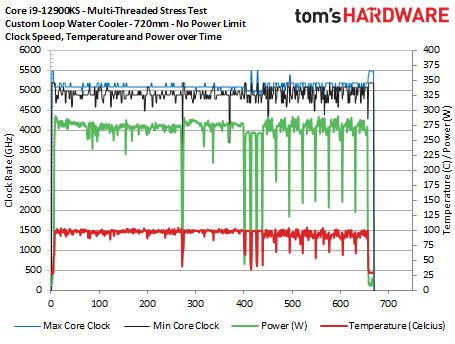

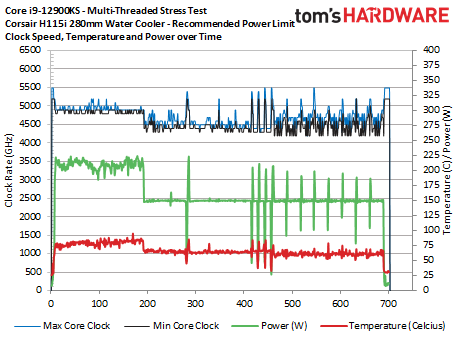
We often don't include Prime95 power measurements in our standard CPU reviews, largely because there is a massive disconnect between this extremely rigorous stress test and the power consumption and thermal load generated by most real-world applications. But given that the 12900K has a higher power rating (and thus heat) than any other mainstream Intel chip, we tested with Prime 95 in several scenarios.
We normally use a 280mm Corsair H115i AIO with the fans cranking away at 100%, but given the 12900KS's heavy power consumption and thermal load, we also tested with our 720mm custom loop as a comparison point. As you can see, the chip peaked at 300W with the 720mm loop but only reached 275W with the H115i AIO.
Removing the power limits causes the chip to run at 100C during extended all-core workloads, but this is at least partially by design. The high thermal load is due to the chip's Adaptive Boost Technology (ABT), which functions much like a dynamic auto-overclocking feature that pushes the clock rates/power to the very limits of your cooler, yet still keeps the cores below the 105C throttle point. Remember, ABT is designed to push the cores right to 100C, extracting the full amount of performance available within the tolerated temperature range.
As expected, the cooling capability, and thus the ABT-enabled clock ceiling, are much lower with the AIO. After lifting the power limits, the chip dropped to an all-core ~4.7 GHz on the P-cores and 3.2 GHz on the E-cores. In contrast, the 720mm configuration stayed at ~4.9 GHz on the P-cores and was mostly steady at 4.0 GHz on the E-cores, although we did see a few sporadic periods of 3.9 GHz.
We also tested Prime 95 with the Intel-recommended 150/241W power limit with a 128-second Tau duration (third slide), and here we can see that the chip respected those power limits perfectly. However, that came at the cost of a drop to a 4.0 GHz all-core frequency on the P-cores and 3.2 GHz for the E-cores.
These Prime 95 stress tests are brutal, and you often won't see this type of power consumption during even the heaviest 'normal' use. The last three images in the album show the 12900KS running through a spate of standard heavily threaded applications (Cinebench, HandBrake, AVX-heavy y-cruncher) to measure power and thermals during the more standard fare. Here, the custom 720mm loop provides nearly the same peak frequencies and power consumption as the 280mm AIO.
Ultimately, thermal density appears to be the biggest challenge during these benchmarks, not silicon quality or ability — there's just too much heat concentrated in the small die for the coolers to extract it from the heat spreader efficiently. As a result, air cooling is completely unusable, and you will reach a rapidly diminishing point of returns if you choose to go beyond a 280/360mm AIO.
However, the Core i9-12900KS will run at the very limits of your cooler, assuring that you get close to the same performance as a heavy overclock, but without the hassle of manual tuning. Manual tuning will provide slightly higher peak performance, but it also comes with much more waste power and heat generation. You also lose the peak 5.5 GHz boost clocks on two cores.


We tested performance in lightly-threaded work with the H115i cooler and both of our power limit settings. To assess peak boost speeds, we ran through our standard series of lightly-threaded tests (LAME, PCMark10, Geekbench, VRMark, and single-threaded Cinebench).
As you can see, the chip readily and frequently jumped to 5.5 GHz, regardless of the power settings. Overall, the 12900K stayed below 70C for most of these tests, though we can see the threaded portions of the PCMark 10 (~900 to 1200 seconds) and three Geekbench runs (~1500 to 1800 seconds) push temperatures and power draw higher during parts of the test run. As you can see, those threaded workloads don't always result in a lower peak boost clock rate. That's because we're plotting the overall CPU temperature, but the chip monitors temps for each core and modulates frequency on a per-core basis. Overall, the 12900KS more than delivers on its 5.5 GHz promise, though your mileage could vary based on your cooler.
As we covered in-depth here, the Alder Lake chips are easily the best overclocking chips we've seen from Intel in several generations. The higher binning of the 12900KS implies that you'll get a cherry overclocking chip, but that is certainly not guaranteed. Unfortunately, due to another important time-sensitive project, we didn't have enough time to manually overclock the 12900KS for our first round of testing. We will circle back and add overclocking testing in an update soon. Much of the attraction of the 12900KS centers on the fact that you don't have to overclock to get close to the pinnacle of performance, so we have more than enough data to work with to give concrete advice.
Intel Alder Lake Core i9-12900KS Power Consumption, Efficiency, and Thermals






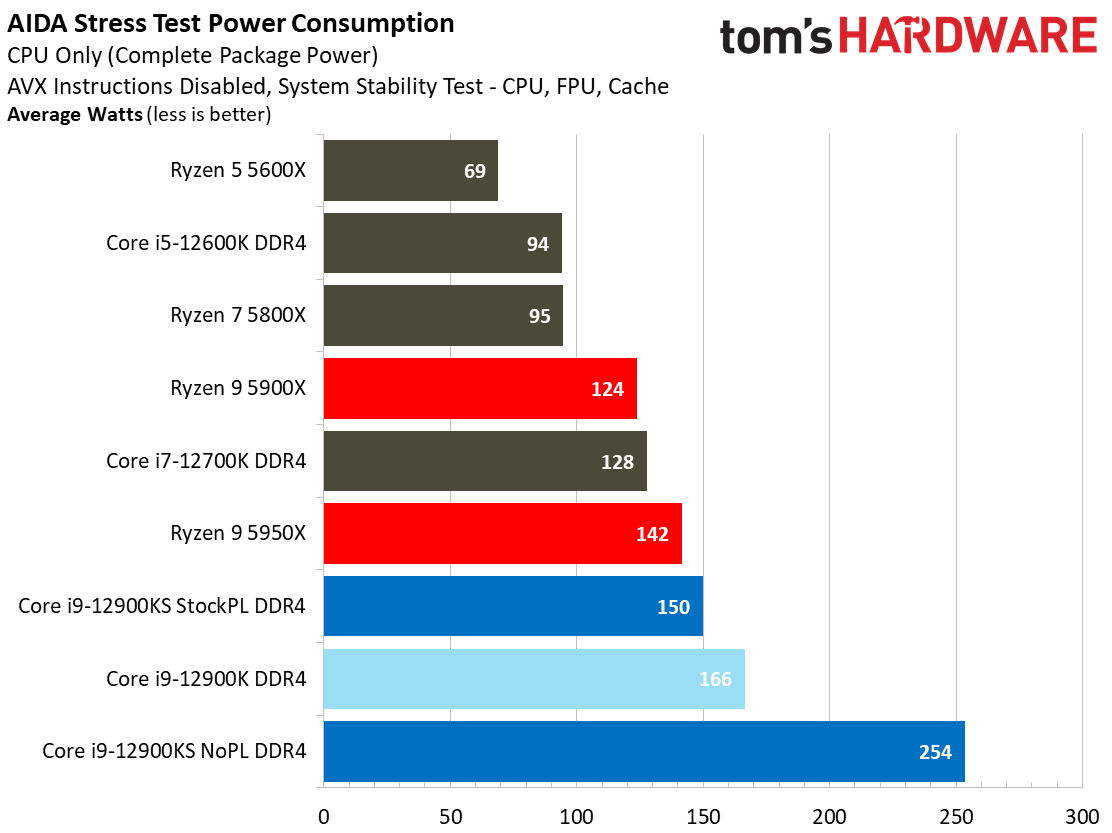

Yes, the Intel Alder Lake chips still suck more power than AMD's Ryzen 5000 series chips, but pairing the Intel 7 process with the hybrid architecture has resulted in big improvements, particularly in threaded work.
Alder Lake's reduction in peak values goes out the window with the performance-at-all-costs Core i9-12900KS. However, although the chip sucks more power, it is much faster than the 12900K. Surprisingly, the 12900KS delivers better power efficiency in our renders-per-day measurements, showing that the extra power consumption comes paired with faster performance and higher-quality silicon that delivers more performance-per-watt.


Here we take a slightly different look at power consumption by calculating the cumulative energy required to perform x264 and x265 HandBrake workloads, respectively. We plot this 'task energy' value in Kilojoules on the left side of the chart.
These workloads are comprised of a fixed amount of work, so we can plot the task energy against the time required to finish the job (bottom axis), thus generating a really useful power chart.
Bear in mind that faster compute times, and lower task energy requirements, are ideal. That means processors that fall the closest to the bottom left corner of the chart are best. As you can see, the Core i9-12900KS rivals the Ryzen 9 5950X with the standard power settings in the HandBrake workloads.
The Rare Few
Intel's Alder Lake pricing has been incredibly competitive against AMD's Ryzen 5000 chips, forcing its competitor to slash prices, but the Core i9-12900KS bucks that trend with a $739 price tag that will probably manifest as $800 at retail. Given the slight gains in gaming, the chip simply isn't worth the premium for the overwhelming majority of gamers and enthusiasts. However, we're sure the chip will find an audience with deep-pocketed productivity-minded users, those building all-out performance-oriented machines with the Nvidia GeForce 3090 Ti, or professional users.
Below, we have the geometric mean of our gaming test suite at 1080p and 1440p and a cumulative measure of performance in single- and multi-threaded applications. Remember that we conducted the gaming tests with an RTX 3090, so performance deltas will shrink with lesser cards and higher resolution and fidelity settings. However, it is noteworthy that a few of our tested titles are approaching a GPU bottleneck at 1080p, so we might see bigger performance deltas when new, more powerful GPUs arrive later this year.




The Core i9-12900KS carves out a 2.7% win in our 1080p game testing, but its biggest problem is the Core i9-12900K's lower price point — the 12900KS' additional 2.7% of performance comes with a 25% price increase. Additionally, GPU bottlenecks mean you won't see any perceivable gains at higher resolutions, at least not with the current crop of GPUs.
In applications, the Core i9-12900KS is 4% faster than the 12900K in threaded work and 6.8% faster in single-threaded work. That expands the lead over the Ryzen 9 5950X, too: The 12900KS is 7.9% faster in multi-threaded and a whopping 25.9% faster in single-threaded work than AMD's finest.
The improved application performance, particularly in Adobe workloads, makes the 12900KS an attractive chip for professionals where time is money and expensive parts are merely a business expense. Intel now allows pairing its Alder Lake consumer chips with ECC memory on motherboards with the workstation-geared W680 chipset, so the Core i9-12900KS could make for a very potent workstation machine that supplants the entry-level Xeon E series. It will also drive workstation GPUs quite nicely and is the only entry-level workstation game in town with connectivity features like DDR5 and PCIe 5.0. Unlike previous Special Edition chips, the 12900KS has a full three-year warranty.
The 5.5 GHz clock speed might leave you more gas in the tank for future GPU upgrades, too. We tested the 12900KS's boosting, power and thermal characteristics extensively, finding that the chip easily and frequently boosts to 5.5 GHz with conventional cooling. It also sustains up to a 5.2 GHz boost clock on all P-cores, though not under all conditions.
The peak 305W of power consumption we recorded has an impact on thermal output, which regularly stays around 100C during heavy multi-core loads. However, it is important to remember that this is enabled by the auto-overclocking ABT feature that's designed to extract the most performance possible out of the available thermal headroom, so it consumes power right up to the limit of your cooler. That means you could see improvements with beefier cooling. You'll also need a robust power supply and a hefty motherboard, so plan on spending handsomely to build out a Core i9-12900KS rig. It is mentionable that the 12900KS will not reach its peak temperatures during the majority of games, as they aren't demanding enough to push the chip to high all-core boost frequencies.
The 12900KS is simply a higher-binned 12900K with some extra boost tech added. Although it isn't guaranteed, this implies you'll get cherry silicon and a better chance at scoring a highly-overclockable chip. Due to time constraints, we haven't had a chance to manually overclock the 12900KS, but we'll add that testing to this article in the coming week.
The Core i9-12900KS is obviously planned to hold the line against AMD's upcoming Ryzen 7 5800X3D. AMD's new chip uses the tried-and-true Zen 3 architecture paired with an astounding 96MB of L3 cache courtesy of its new 3D chip stacking tech. AMD says the 5800X3D will be the fastest gaming chip in the world, but we suspect it might be a very close race.
However, the race isn't close when it comes to pricing — the 5800X3D is only $449 and drops into affordable AM4 motherboards. You might sacrifice some of the leading-edge connectivity, but the 5800X3D will probably offer far more bang for your gaming buck even if it isn't the absolute fastest. The eight-core 5800X3D won't be able to keep pace with the 16-core 12900KS in any other type of work, though.
Additionally, AMD's Ryzen 9 5950X now sells for around $600, so it will also be a better value than the 12900KS for some types of work — but don't forget that the more reasonably-priced 12900K is still better than the 5950X for just about everything.
In the meantime, the Core i9-12900KS represents Intel throwing value and power consumption out the window in a no-holds-barred attempt to retain the performance crown, particularly in gaming. The chip likely won't find broad acclaim outside of the professional market, and its price-to-performance ratio certainly doesn't justify its price tag for the average enthusiast.
However, the Core i9-12900KS might allow Intel to cling to the title of having the fastest gaming chip in the world, a nearly priceless distinction for the Alder Lake brand. Make no mistake: the Special Edition Core i9-12900KS is the fastest desktop PC chip ever built. At least for now. The Core i9-12900KS goes on sale on April 5, but we won't know if Intel succeeded in its mission to retain the gaming crown until AMD's Ryzen 7 5800X3D arrives later this month. Stay tuned.
| Intel Socket 1700 DDR4 (Z690) | Core i9-12900KS, Core i9-12900K, Core i7-12700K |
| Row 1 - Cell 0 | MSI Z690A WiFi DDR4 |
| Row 2 - Cell 0 | 2x 8GB Trident Z Royal DDR4-3600 - Stock: DDR4-3200 14-14-14-36 / OC: DDR4-3800 - All Gear 1 |
| AMD Socket AM4 (X570) | AMD Ryzen 9 5950X, Ryzen 9 5900X, Ryzen 7 5800X |
| MSI MEG X570 Godlike | |
| Row 5 - Cell 0 | 2x 8GB Trident Z Royal DDR4-3600 - Stock: DDR4-3200 14-14-14-36 | OC/PBO: DDR4-3800 |
| All Systems | Gigabyte GeForce RTX 3090 Eagle - Gaming and ProViz applications |
| Row 7 - Cell 0 | Nvidia GeForce RTX 2080 Ti FE - Application tests |
| 2TB Sabrent Rocket 4 Plus | |
| Silverstone ST1100-TI | |
| Row 10 - Cell 0 | Open Benchtable |
| Row 11 - Cell 0 | Arctic MX-4 TIM |
| Row 12 - Cell 0 | Windows 11 Pro version |
| Cooling | Corsair H115i, 720mm Custom loop |
- MORE: Raptor Lake All We Know
- MORE: Best CPUs for Gaming
- MORE: CPU Benchmark Hierarchy
- MORE: AMD vs Intel
- MORE: All CPUs Content

Paul Alcorn is the Editor-in-Chief for Tom's Hardware US. He also writes news and reviews on CPUs, storage, and enterprise hardware.
-
hotaru251 i'd take a slower cpu, lose max of 5% frames, and not burn my cpu out in few yrs due to uncontrolalble temps.Reply -
TerryLaze Reply
Temps are automatically controlled by the CPU itself at 100 degrees (which is 10% below what the CPU can take) and that goes for any intel CPU.hotaru251 said:i'd take a slower cpu, lose max of 5% frames, and not burn my cpu out in few yrs due to uncontrolalble temps.
Also temps at those levels are determined by Vcore and the KS is a better bin so it will use less Vcore.
Bottom line, if you push the S and non-s to the same clocks the S one will use less Vcore and be cooler.
Still not worth the increase in money, but also nothing to do with higher temps. -
VforV ReplyIntel's Special Edition hits 5.5 GHz with ease.
But at what cost?Oh, here it is:
The peak 305W of power consumption we recorded has an impact on thermals, which regularly stay at 100C under heavy multi-core loads.
And this:
...
If this Alder Lake pushed to the extreme does not beat 5800X3D, it will be the laughing stock of everyone. So intel absolutely needs to win.
12900K's thousand-unit price (effectively the wholesale MSRP) lands at $739, so we can expect to see these chips at retail for around $775 to $800 at launch.
That's a surprising premium over the 16-core 32-thread Ryzen 9 5950X that now retails for around $600, and it's also much more expensive than the $449 Ryzen 7 5800X3D...
That being said, I think they will beat 5800X3D, but if it's just a 5% difference in favor of 12900KS, then that is still very very bad, because all the other pluses will be with the 5800X3D.
Intel needs to beat the 5800X3D with at least +10% more performance in gaming for this CPU to make SOME sense with all those minuses stated above.
P.S. This just occurred to me how similar situation is this with the 3090Ti vs RX 6950 XT situation and how nvidia is in the the exact same spot with 3090 Ti (like intel with 12900KS) vs AMD (again) with their 6950XT (like with their 5800X3D). Can anyone spot the 2 desperate companies here? :ROFLMAO: -
Johnpombrio Like Hot said, I decided to get an i7-12700K simply due to wanting to run the CPU on air. I got a decent 4.7GHz Performance and what? 4GHz on E cores with a 70C temp on a Cooler Master Hyper 212 black RGB air cooler with one fan. I literally cannot hear the cooler fan spin up when under full load. I was able to get it up to 5GHz but it was too hot on air. I could never tell the difference anyway.Reply
What did make a difference was having my Samsung 980 Pro NVME finally running at full speed and having an EVGA RTX 3080Ti FTW3 which also is very quiet and stays under 75C under benchmarks. My memory is at 65C which I was surprised after reading the article about using a copper shim over the memory modules if/when they run hot.
Overall, I am very satisfied with my first purchase of an Intel chip that was not at the top of its class. -
hotaru251 Reply
duh?TerryLaze said:Bottom line, if you push the S and non-s to the same clocks the S one will use less Vcore and be cooler.
Still not worth the increase in money, but also nothing to do with higher temps.
thats a no brainer given the S are special binned for that exact reason.
my point was for daily rig nobody wants to run their CPU @ 100 degrees long term.
Only niche target who could justify S cpu's would be ppl who are really into XOC. -
-Fran- If Intel is only going to give 1 year warranties on these, that's all you need to know. You'd have to be the biggest imbecile in history if you don't take that 100°C operational temp as a red flag with these.Reply
Well, inb4 mental gymnastics galore.
Regards. -
TerryLaze Reply
Nobody runs prime95 with no power limit daily long term...hotaru251 said:duh?
thats a no brainer given the S are special binned for that exact reason.
my point was for daily rig nobody wants to run their CPU @ 100 degrees long term.
Only niche target who could justify S cpu's would be ppl who are really into XOC.
You overclock when you run things that can benefit from overclocking, you don't run overclocking just to produce heat.
-
jacob249358 cpu that pulls more power than my whole PC. How do you even cool this thing? liquid nitrogen? dropping ice cubes in your pump?Reply